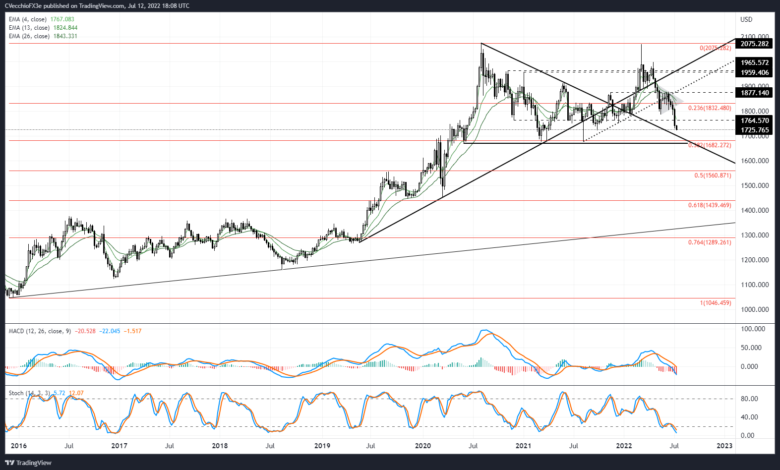Gold Price Forecasting: Insights for Sellers in Brussels

Few commodities wield as much power as gold in the complex realm of commerce. Understanding the intricate dynamics of gold pricing is a strategic need for sellers in Brussels, not just a financial one. The global gold market is a tapestry of economic conditions, geopolitical events, and intricate supply-demand patterns. In this essay, we will engage on a journey to untangle the nuances of gold price forecasts, giving Brussels sellers with actionable information and tactics for navigating the volatile landscape.
The Crucial Role of Gold Prices
Gold, often hailed as a safe-haven asset, plays a pivotal role in shaping the economic and financial landscapes globally. Sellers in Brussels find themselves intricately connected to the undulating waves of the gold price in Belgium, influencing profit margins, consumer behavior, and overall market dynamics. This article delves into the importance of gold prices for Brussels sellers, shedding light on the implications of price changes on businesses operating in the region.
Understanding the symbiotic relationship between gold prices and economic health allows sellers to anticipate market movements. In times of economic uncertainty, gold tends to shine as a refuge, influencing buying patterns and creating a ripple effect on local gold dealers in Brussels. Conversely, economic upswings may lead to increased consumer spending and a shift in focus from gold as a safe-haven asset to more traditional investments.
Gold Price Influencing Factors
Understanding the forces that drive gold prices is like to deciphering a complicated code. The ever-changing tapestry of gold values is influenced by global economic conditions, inflation rates, geopolitical events, and the complicated dance of supply and demand. Sellers in Brussels, as in any other part of the world, must understand the impact of these elements in order to make informed judgments. Each aspect, from the repercussions of worldwide conflicts to the delicate balance of jewelry demand and central bank reserves, adds a new brush to the canvas of gold pricing.
Global economic conditions, as measured by GDP growth or contraction, have a significant impact on gold prices. During economic downturns, investors frequently rush to gold as a safe-haven asset, pushing increasing demand and, as a result, its price. In contrast, robust economic growth may reduce the appeal of gold, with investors shifting to more dynamic assets.
Examining Historical Patterns
As they say, history is the finest teacher. Historical trends provide vital insights in gold price forecasting. Sellers can gain insights about anticipated future movements by studying past patterns and discovering correlations. This section delves into historical trends, examining peaks and troughs as well as the larger environment in which gold prices have ebbed and flowed.
Historical trends reveal patterns that repeat over time. Economic upheavals, geopolitical shifts, and global crises can all influence cyclical tendencies, which sellers can spot. Understanding these trends enables sellers to anticipate probable market moves and make informed decisions, reducing risks and capitalizing on opportunities.
Today’s Gold Market Overview
The present is the pivot around which future decisions are made. A thorough understanding of the present gold market conditions provides Brussels sellers with the insight required to handle uncertainties. We investigate the elements that shape today’s market, from liquidity levels to speculative trading actions. Recent price patterns and variations, in conjunction with important indications and market mood, serve as the foundation for sellers to make strategic judgments.
A plethora of macro and micro factors influence current market circumstances. The ease with which sellers can enter or exit positions in the gold market is influenced by liquidity levels. Short-term swings are exacerbated by speculative trading activity, which are influenced by market emotion and economic indicators, adding complexity to the overall market landscape.
Forecasting Methods
Analyzing gold prices requires a combination of technical and fundamental analysis. Moving averages, support and resistance levels, and trend assessments provide a technical perspective, whilst economic indicators, central bank policies, and world events provide fundamental insights. Sellers in Brussels might use forecasting tools to keep ahead of the competition.
Technical analysis is the process of identifying trends and making predictions using past price data and trade volume. Simple moving averages (SMA) and exponential moving averages (EMA) smooth out price data, making it easier to discern trends over different time frames. Support and resistance levels serve as psychological barriers, indicating potential market turning points.
Fundamental analysis, on the other hand, looks at the broader economic issues that influence gold prices. Economic indicators such as job data and consumer spending provide insight into an economy’s health, impacting market sentiment. Central bank policies, such as interest rate choices and quantitative easing, have a direct impact on currency values and, as a result, gold prices.
Understanding Gold Price Fluctuations
The real-world impact of gold price variations is obvious for Brussels sellers. The ebb and flow of gold prices affects every area of the company, from profit margins to customer behavior. Adaptation strategies, such as dynamic pricing, savvy inventory management, and focused marketing activities, become critical.
Dynamic pricing strategies enable vendors to alter their rates based on market conditions in real-time. During instances of rising prices, sellers may choose to take advantage of the momentum by raising prices to maximize profit margins. During a downturn, however, competitive pricing methods may be used to maintain market share and client loyalty.
Understanding and Reducing Risks
Risk management becomes the compass that guides sellers through the choppy waters of gold price fluctuation. Diversification, insurance, and hedging approaches provide risk-mitigation instruments. A solid risk management approach requires being up to date on market trends, using analytical tools, and participating in industry networks.
Product diversification is a risk-mitigation approach that entails broadening the range of items sold. Sellers can mitigate the impact of variations in the price of any particular commodity, including gold, by offering a diversified range of products. Another option in the risk management toolbox is price volatility insurance, which provides a financial safety net in the event of unforeseen market swings.
Hedging tactics entail the use of financial instruments such as futures contracts and options to mitigate the impact of negative price changes. Sellers can protect themselves from potential losses by entering into contracts to buy or sell gold at a predetermined price. Furthermore, being up to date on market developments is critical for risk management. Real-time data enables sellers to make rapid decisions and alter strategy in response to changing market conditions.
Understanding Gold Market Dynamics: A Complete Guide for Brussels Sellers
The gold market’s dynamic nature necessitates ongoing adaptation and learning. Brussels sellers who study gold prices in depth might turn market problems into opportunities. This comprehensive book serves as a road map, helping sellers to negotiate the complexity of the gold market, nurture long-term growth, and ensure resilience in the face of ever-changing market dynamics.
Continuous study and adaptability are required to master the complexities of the gold market. Sellers in Brussels are urged to use the ideas in this book as a foundation for strategic decision-making. Sellers should position themselves for success in the ever-changing world of gold trading by remaining agile in response to market shifts, employing good forecasting techniques, and embracing risk management strategies.
As sellers in Brussels negotiate the volatile world of gold prices, they should perceive setbacks as opportunities for growth rather than impediments. Each volatility in gold prices provides an opportunity to fine-tune strategy, improve market understanding, and create resilience. By mastering the complexities of the gold market, Brussels sellers can not only survive but also grow, contributing to the liveliness of the local economy and the worldwide marketplace.




